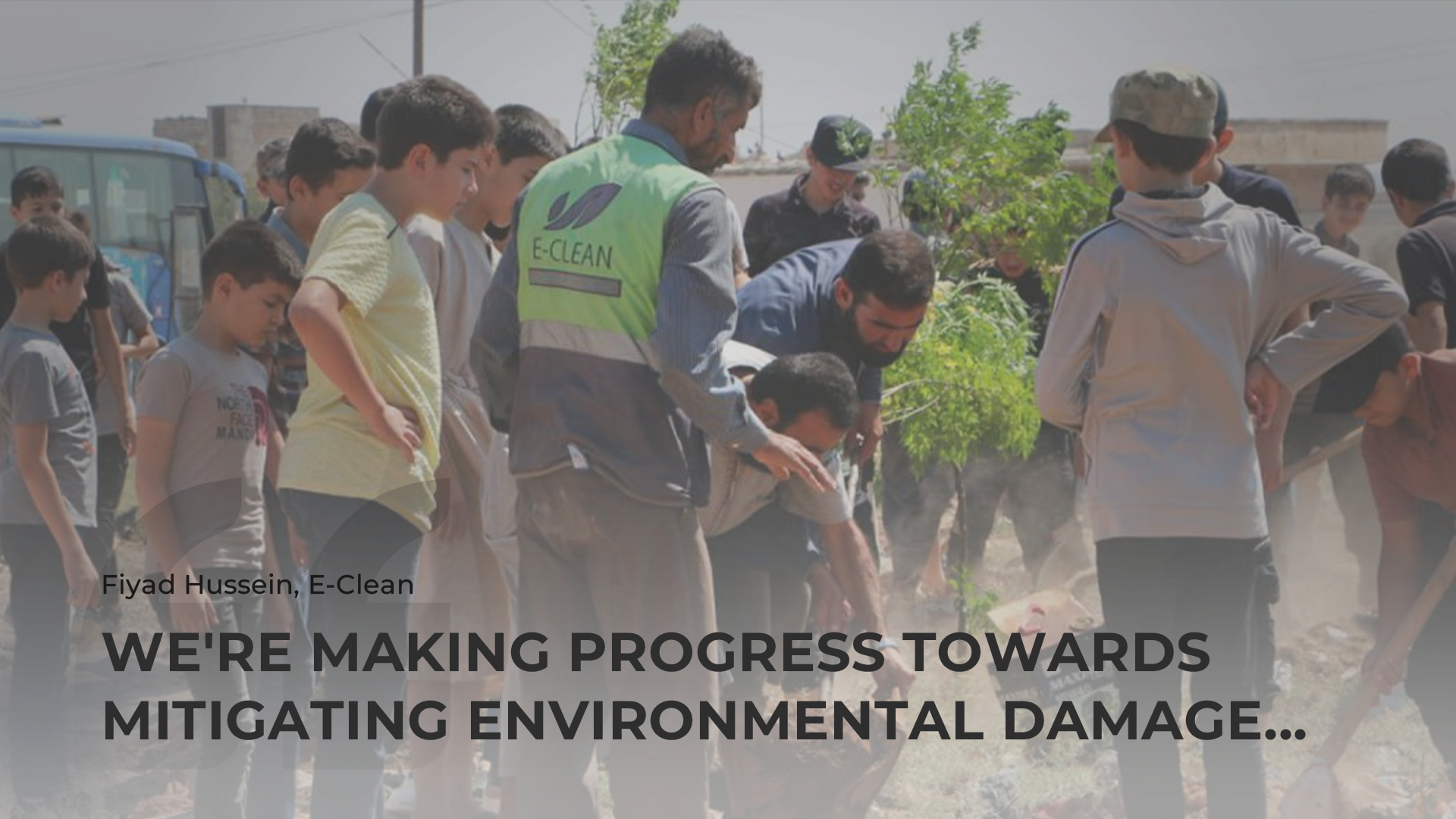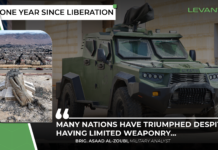
The ongoing conflict in Syria has brought about widespread devastation, not only to human lives but also to the environment. As the war enters its fourteenth year, the environmental damage remains a largely overlooked consequence of the conflict. What are the immediate and long-term environmental impacts of the war in Syria, the broader regional and global implications, and the various efforts to mitigate and recover from this damage?
Devastation on the Ground: Local Environmental Damage
The environmental impact of the Syrian conflict has been profound. Over the past 13 years, the war has caused significant damage to infrastructure, leading to widespread pollution and disruption of agriculture and food production. Among the main factors has been the deliberate targeting of vital resources such as water, sanitation, and agriculture infrastructure as a means of harming civilians and displacing populations.
L24 spoke with Fiyad Hussein, of E-Clean, a waste management institution with a focus on sustainable projects to rehabilitate and maintain the beauty, health, and environment of the liberated territories. Hussein, the Director of the Media Co-Ordinations office, said the absence of infrastructure is a major contributor to regional environmental issues.
“Destruction and overcrowding, lack of adequate resources for the overpopulated society due to internal displacement and the ‘Gazafication’ of Syrians in the liberated areas (large population in a small land mass),” are all, according to Hussein, preliminary causes for the ongoing health and climate dangers brought about by the ongoing conflict. The overcrowding of many areas due to constant displacement and confinement from attacks and siege tactics exacerbates the strain on the already damaged infrastructure and complicates environmental challenges faced by local communities.
The environmental situation in Syria has parallels with Gaza, which has also suffered immensely due to ongoing conflicts. According to a report by the Guardian, the destruction in Gaza has led to severe pollution, water contamination, and a significant loss of biodiversity – which may reach the level of a war crime – and is very similar to issues seen throughout the crisis in Syria. The UN has also highlighted the major environmental damage in Gaza, emphasizing the need for international intervention and sustainable recovery efforts.
Both regions live under the constant threat of outbreaks of waterborne illnesses such as hepatitis, cholera, and cases of severe diarrhea and jaundice, mainly among children and infants. Lack of access to clean potable water for drinking as well as agricultural and sanitation needs continue to threaten the health and food security of both those in Gaza and Syria alike.

One of the most visible impacts is the destruction of agricultural land, which has significantly affected food production. Contaminated water sources, damaged infrastructure, and severe water scarcity have directly impacted both human health and agriculture.
Attacks on arable land, and agricultural infrastructure including irrigation systems, wells, and pumping systems as well as strikes on farmers and crops have all been used as weapons of war. Additionally, pollution from military activities and the lack of proper waste management have further degraded the environment. These issues are compounded by the fact that many areas lack the infrastructure to handle the increased waste and pollution, leading to unsanitary conditions and further environmental degradation.
A 2023 OCHA report mentioned that “Syria’s sharp rise in environmental hazards wreaks havoc on agricultural communities, robs people of their livelihoods, and makes it difficult for people to return to their homes and rebuild their lives. It also undermines economic development and social stability, as people’s coping mechanisms become increasingly depleted.”
War and global climate change coupled with pollution and a lack of environmental programs and oversight have created a perfect storm of increasing temperatures, reduced rainfall, and a lack of integral water and sanitation infrastructure. Syria is experiencing its worst drought in 70 years, severely impacting crops and food security. Recent studies have shown that approximately 15,000 hectares have already been reduced to desert with another 85% under threat. This desertification crisis highlights the urgent need for unified efforts to combat environmental degradation and climate change.
The environmental damage extends beyond physical destruction. According to a 2018 report, Beyond The Debris, by Crisis and Environment, the war has led to significant air pollution due to the burning of waste and the destruction of industrial facilities. This pollution poses severe health risks to the local population and contributes to broader environmental degradation.
Ripple Effects: Regional and Global Consequences
The environmental damage in Syria extends beyond its borders, affecting the entire region and contributing to global environmental and climate issues. The destruction of forests and agricultural lands has led to deforestation and loss of biodiversity. This deforestation not only impacts local ecosystems but also contributes to global climate change by reducing the number of trees that can absorb carbon dioxide.
Water scarcity is another significant regional issue. The conflict has disrupted water sources, leading to a decrease in water availability for neighboring countries such as Jordan, and Iraq. This scarcity exacerbates tensions and conflicts over water resources in an already volatile region.

Furthermore, the environmental damage in Syria has global implications. The increase in pollution and greenhouse gas emissions from the conflict contributes to global climate change. As climate change accelerates, the consequences are felt worldwide, with more extreme weather events and rising sea levels.
Hope Amidst Ruins: Mitigation and Recovery Efforts
Despite the challenges, various efforts are being made to address and mitigate the environmental damage caused by the conflict. Organizations such as E-Clean strive to reduce environmental and health dangers through managing and treating solid and hazardous waste, centralizing public landfills, and contributing to reforestation and the preservation of green public spaces.
The project has placed strong emphasis on awareness programs, educating primary school students, IDP camp residents, and the public in parks about the importance of environmental preservation. By collaborating with government and non-government organizations, E-Clean has been able to enhance green spaces and promote reforestation through extensive tree-planting initiatives.
According to Hussein, public clean-up drives are another key aspect of E-Clean’s work. Organizing clean-up efforts in cities, schools, parks, and mosques helps maintain cleanliness and reduce pollution. Additionally, the foundation has developed innovative waste collection methods, such as environmentally friendly underground bins, to improve waste management practices.

Recycling projects are a critical component of their strategy, says Hussein, with ongoing research and implementation of long-term solutions for solid and green waste recycling. “Specialized teams are deployed to remove scattered waste across the region, ensuring that waste clearance is handled efficiently and effectively. E-Clean also partners with IDP camp directors and local authorities to improve waste management practices through collaborative efforts.
“Through these initiatives,” notes Hussein, “we are making significant strides toward mitigating environmental damage and promoting sustainable practices in a challenging context.” Efforts to develop and implement environmental policies are also underway. Workshops have been established at three levels: local government, the E-Clean Foundation, and local community councils and leaders. These workshops aim to address environmental concerns and develop actionable plans for mitigating the impacts of the conflict on the environment.
A Path Forward: Ensuring Sustainable Recovery
Even though the environmental damage caused by the conflict in Syria is extensive and has far-reaching consequences, local initiatives like those of E-Clean and environmental sustainability projects like those of the UN aim to make significant strides in addressing these issues and promoting sustainable practices. The cooperation between local communities, government, and international organizations is crucial in these efforts.








